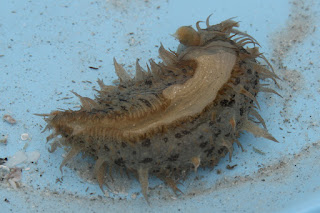One of my favorite things about my work is learning new things about environments I'm familiar with - going outside, exploring, and asking questions! My family and I went walking along Sanibel Island during low tide and came upon a mystery. We found these critters just floating in the shallow waters and had no idea what they were. They were squishy and had "hairy" tentacles all over its back, but its belly was smooth. We didn't know what it was, so we started to investigate and ask questions, biomimicry style.
 |
| Mystery Critter |
 |
| Mystery Critter's Belly |
The sea hares are detrivores and herbivores feeding on microscopic organisms on the sand. The sea slugs
near Florida have a particular taste for cyanobacteria and they only live for a year. They metabolize toxins
as food. I wondered if their presence is an indicator species for poor water quality - the water does seem
greener and more cloudy than in years previous.
I wondered about their soft bodies and how there are vulnerable to predation, but it turns out that slugs
are chemically protected from predation due to skin glands that secrete toxic or foul-tasting compounds -
no one wants to eat them! Especially the slugs that eat cyanobacteria - they taste worse than most. So
predators aren't an issue and they can float right up to the shore line without a shell and stay whole -
chemically defended by their skin!
The outgrowths I was calling tentacles are actually papualle and I couldn't find any function that they carry
out, although I stand by my camoflague idea. And their smooth belly is how they move around on rocks
and sand. I don't know why they were floating in the tidal pools. I can imagine that the rains from the
previous night dislodged them from their homes in the sea grass and we found them floating. Most were
still alive, but I wouldn't think for much longer.
So many fun things to learn when you go outside, ask questions, and investigate!
References:
http://www.sms.si.edu/irlspec/Bursatella_leachii.htm
http://en.wikipedia.org/wiki/Bursatella_leachii
http://en.wikipedia.org/wiki/Sea_slug
http://www.seaslugforum.net/find/bursleac
http://slugsite.us/bow/nudwk391.htm

No comments:
Post a Comment